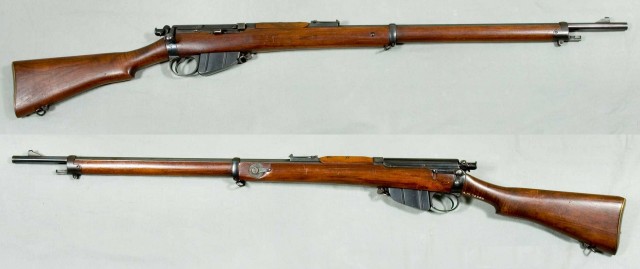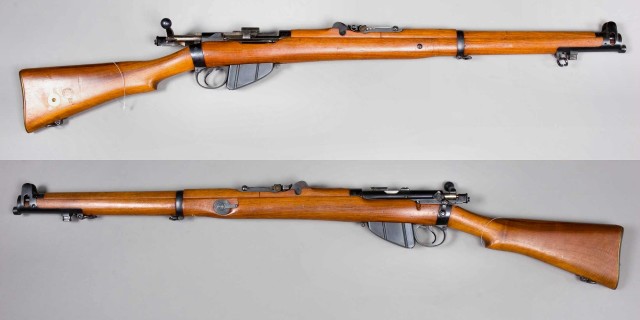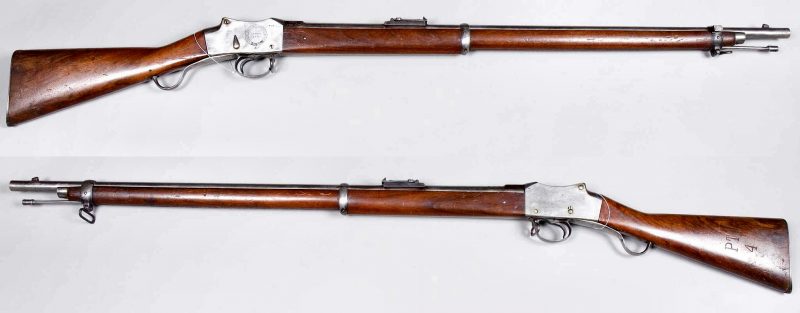The late nineteenth century saw huge steps forward in firearms technology. Many fundamentals of modern weaponry were created in this period. Even among the top commanders of the British army, men who could barely agree on what uniforms should be worn, there was agreement on one thing – better guns made for better soldiers.
So what were the improvements that made these weapons so effective?
1. Breech-Loading Rifles
Up until the late nineteenth century, reloading a gun was an arduous business and an incredibly stressful one in the heat of battle. Weapons were muzzle loaded, meaning that a soldier had to move out of the firing position, turn the mouth of the gun so that he could access it, pour in the powder, shot and wadding, ram the whole lot home, and finally turn the gun to face the enemy again. Whether facing charging Zulus or a French musket line, that time spent reloading was time when the enemy came closer to killing you and you couldn’t fire back. Even your bayonet was facing in the wrong direction, if you could even have a bayonet fixed while reloading.
The introduction of breech-loading rifles – in Britain the Martini-Henry and the Snider – changed all this. Weapons could be reloaded quicker and with far less effort while staying pointed in the right direction. Soldiers could even reload while lying flat on their bellies, making them smaller targets and creating a stable firing platform.
Of all the changes to rifles in the late nineteenth century, this was the most fundamental.
2. Magazines
Breech loaders made reloading quicker and easier, but they still left a critical few seconds between each shot, as the soldier extracted the cartridge from the old round, took another from his ammunition pouch, and reloaded.
Magazine-loaded rifles changed that. Now several shots could be loaded up in advance. As long as the rifle had an effective mechanism to draw the bullet up into the chamber, a series of shots could be fired in quick succession – as many as could be fitted into a single magazine.
Like most of the innovations that improved Victorian firepower, magazines allowed faster firing while reducing the level of risk for the man with the gun. A rifle line became increasingly deadly for its opponents and increasingly safe for the men in it.
3. Bolt Action Mechanisms

The effectiveness of magazine fed guns depended upon the effectiveness of the mechanism feed new cartridges into the chamber. The great innovation here was the bolt action.
Bolt action guns had been developed in the early nineteenth century, but it took a while for the technology to reach the battlefield. The first appearance of bolt action weapons in warfare came in 1864 with Prussian needle rifles, with Union and French armies quickly following the trend. The British were the first to widely combine this with a magazine feed, with the Lee-Metford rifle in 1888.
Bolt action mechanisms allowed every part of reloading to be achieved in one or two movements. A single handle unlocked the bolt, ejected the spent cartridge, cocked the firing pin, and pushed a new cartridge into the breach. This cartridge might be inserted manually, or more efficiently pulled from a magazine once these were introduced.
Compared with the elaborate reloading regimes of the past, it was a huge time saver.
4. Small Calibre Ammunition
It might seem strange to argue that smaller calibre ammunition was advantageous. Some men serving at the time argued that smaller rounds would reduce the stopping power of bullets and the damage they did to the enemy, making rifles less effective.
But what was considered “small calibre” at the time, such as .30” bullets, would not seem so small today. As manufacturers found ways to make ammunition effective even at a smaller size, for example through jacketing and more aerodynamic shapes, small calibre rounds turned into an advantage instead of the disadvantage many had feared. Carrying smaller ammunition reduced the cost per round and allowed soldiers to carry more bullets due to the reduced weight.
5. Smokeless Propellants
One innovation of the 1880s had nothing to do with firing rates but had a profound effect upon the very air of the battlefield. This was the invention of smokeless propellants.
The first smokeless black powder was invented in 1885, and within a decade armies were starting to adopt it for their bullets.
The effect was huge. For centuries, battlefields had been thick with the smoke of black powder weapons. Now the air became clear.
For soldiers, using smokeless propellants had several advantages.
Firstly, they made it easier for them to see what they were firing at. No longer wreathed in dense clouds, their visibility was vastly improved.
Secondly, smokeless propellants made it harder for the enemy to identify the location of the shooter. This made little difference when fighting in massed ranks, but for skirmishers and snipers it was a significant leap forward. Loose, less ranked forms of warfare were starting to take over, as seen in the Boer Wars, and though the armies of the great powers would be slow to learn this lesson, when they did, their use of smokeless powder would be invaluable.
6. Short Rifles
Introduced to the British army by commander-in-chief Lord Roberts, the Lee Enfield rifle is still in use in some parts of the world over a century later. One innovation brought in as the Lee Enfield developed was the shortening of the barrel.

Like smaller calibre ammunition, shorter barrels created controversy. Initially used to allow cavalry to more easily draw and fire, short barrels were later provided for the infantry as well. Though opponents feared that they would increase recoil and reduce accuracy, short Lee Enfields proved excellent weapons. Like smaller ammunition, they reduced the burden upon soldiers in the field, as well as making weapons more manoeuvrable in the faster, more fluid warfare that was to come.
